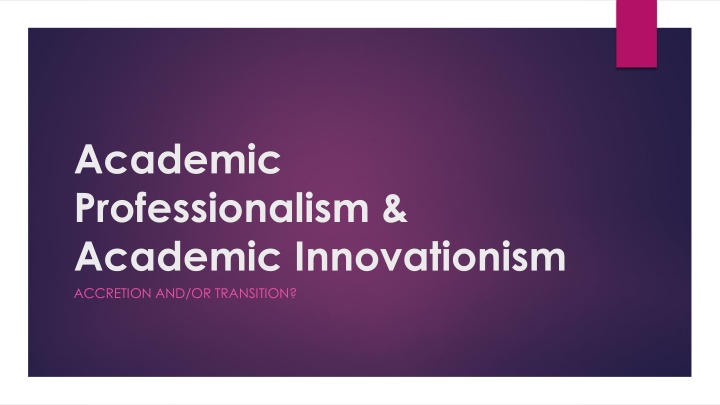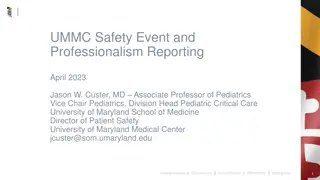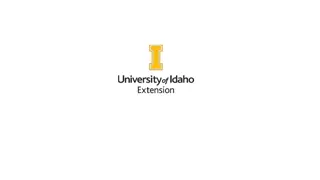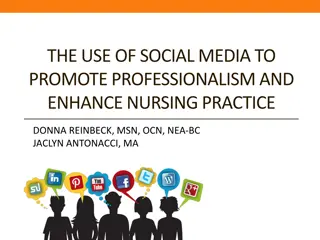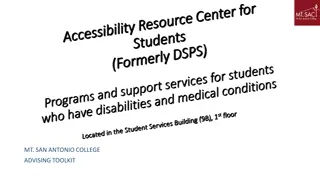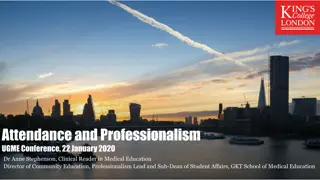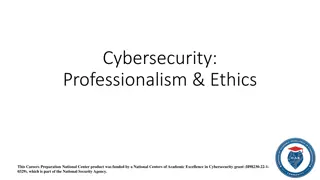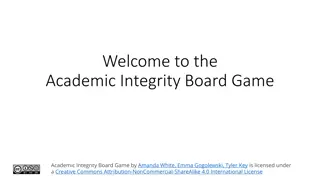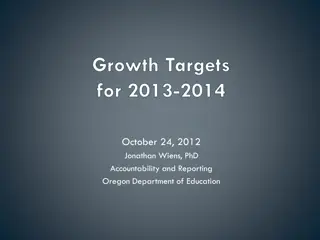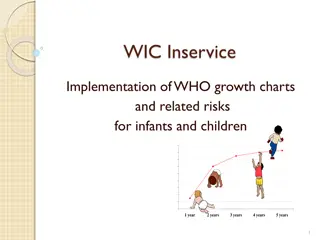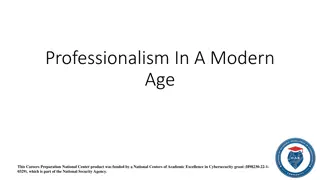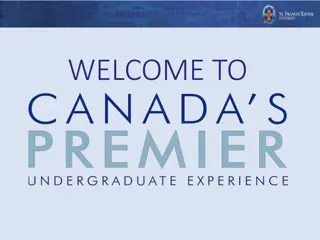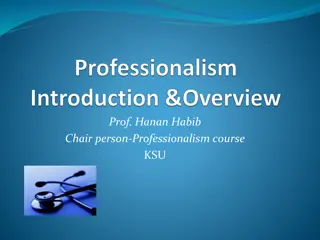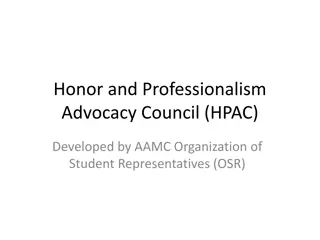Academic Professionalism & Innovationism: Growth and Context
The content delves into the growth of scientific research output, the transformation in academic professionalism and innovationism, the changing landscape of the U.S adult population with postsecondary degrees, historical legislative contexts, the competitive policy environment, key legislations of the 1980s, and diverse actors, ideologies, and policy windows shaping the academic domain.
Download Presentation

Please find below an Image/Link to download the presentation.
The content on the website is provided AS IS for your information and personal use only. It may not be sold, licensed, or shared on other websites without obtaining consent from the author.If you encounter any issues during the download, it is possible that the publisher has removed the file from their server.
You are allowed to download the files provided on this website for personal or commercial use, subject to the condition that they are used lawfully. All files are the property of their respective owners.
The content on the website is provided AS IS for your information and personal use only. It may not be sold, licensed, or shared on other websites without obtaining consent from the author.
E N D
Presentation Transcript
Academic Professionalism & Academic Innovationism ACCRETION AND/OR TRANSITION?
Growth of Scientific Research Output of Top 188 U.S. Universities, 1980-2010 1980 R&D Expenditures (all sources): 2010 R&D Expenditures (all sources): $4.4 billion $46.9 billion Web of Science Publications: Web of Science Publications: 191,000 555,000 Web of Science Citations: Web of Science Citations: 4.3 million (1980 articles measured in 2015) 10.7 million (2005 articles measured in 2015)
Growth of U.S. Adult Population with Postsecondary Degrees, 1987-2010 As of 2015: Bachelor s Degrees: 68.9 m. (32.5% of population age 25+) Advanced Degrees: 25.5 m. (12% of population age 25+) First Professional/Doctorate Degrees: 10.1 m. (5% of population age 25+) Source: National Center for Education Statistics (2015)
Historical Context CONTEXT KEY LEGISLATION EXPLANATIONS 1. 2. 3.
Context of Competitiveness Policy R. Solow (1956, 1957) comparative studies of economic growth: 87% residual after primary factors of production (land, labor, and capital) taken into account. E. Denison (1985): ~66% of residual due to technological innovation; ~33% due to improvements in human capital. U.S. competitive situation in 1970s: After-tax profits 10% in 1965; 4.5% in 1975. Productivity gains plateauing at 1% per year. Japanese industry surging in steel, automobiles, machine tools, and consumer electronics. Boyer/Cohen discovery of gene splicing technology (1973) creates an entirely new industry in late 1970s and early 1980s from academic science.
Key Legislation of the 1980s Bayh-Dole Act of 1980: Reduces restrictions on university patenting of discoveries made with federal funds and encourages licensing of patented discoveries to private firms. Stevenson-Wydler Act of 1980: Required federal laboratories to actively participate in technology transfer activities. National Cooperative Research Act of 1984: Provided special anti-trust status to R&D joint ventures and encouraged broad government-industry- university cooperative funding.
Actors, Ideologies, & Policy Windows The corporate influence argument: S. Slaughter and G.R. Rhoades (1996) The state interest/ideological convergence argument: E.P. Berman (2012) The policy window argument: J. Kingdon (1984)
PATENTING/LICENSING UNIVERSITY-INDUSTRY RESEARCH CENTERS 50 STATE MOBILIZATION GRAND CHALLENGES INTERDISCIPLINARY CLUSTER HIRING 1. 2. Mechanisms 3. 4. 5.
Licenses and Licensing Income Licenses Executed Licensing Income (in millions) Over 100,000 Cumulative Licenses $37 b. in Cumulative Licensing Income 7942 $2,520 $2,326 5328 4516 $1,419 3101 $687 1229 $218 1991 1997 2003 2009 2105 1991 1997 2003 2009 2105
University-Industry Research Centers 1980: first NSF funding of University-Industry Research Centers. Cohen, Florida, and Goe (1990): Estimate of 1,100 UIRCs and $1 b. in external support by 1989. Notable examples: Cal Tech s Silicon Structures Program, MIT s Polymer Processing Center, Microelectronics Center of North Carolina (MCNC), Minnesota Microelectronics and Information Sciences (MEIS). About 70% of industry funding for university research channeled through UIRCs.
Mobilization in the 50 States: Examples New York STAR Centers for Advanced Technology (1983) Georgia Research Alliance (1984) California Institutes of Science and Innovation (2000) UStar (2006)
Grand Challenges Kenneth Wilson (1989): Advocacy of supercomputering as grand challenge Bill and Melinda Gates (2003): Global Health Challenges ($458 m. initially) 2001-2015: Huge growth in federal grand challenge competitions. As of 2015, 440 challenges had been conducted by federal agencies with over $150 million in prizes awarded. Obama s 21stCentury Grand Challenges included: (1) mapping the human brain, (2) making solar energy cost competitive, (3) mapping asteroids and preventing damage to Earth, and (4) saving newborns lives in poor communities. Xprizes: Multimillion dollar prizes fielded on topics such as low-cost robotic space exploration, conversions of carbon emissions, wireless devices for remote diagnosis of illnesses, ocean discovery, advances in adult literacy, and contributions to artificial intelligence.
Interdisciplinary Cluster Hiring Duke University (1988): Crossing Boundaries University of Southern California (1994) University of Wisconsin-Madison Cluster Hiring Program (1998) Perhaps 50 research universities have engaged in large-scale cluster hiring programs over last 15 years.
ENTREPRENEURIAL UNIVERSITIES INDUSTRIAL CLUSTERS UNIVERSITIES ROLE IN TOP INVENTIONS CORPORATE DOMINANCE NEW UNIVERSITY DESIGNS? 1. 2. Consequences & Import 3. 4. 5.
Two Entrepreneurial Universities Others Hope to Emulate Stanford University ~5,000 companies started by Stanford faculty, students, or alumni Mass. Institute of Technology ~35,000 firms started by MIT faculty, students, or alumni, 30,000 still active. Estimate that these firms generate $19 trillion in annual revenues 53 largest of these firms had $267 b. in sales in 2010 ~4.6 m. people employed in these firms, 30% of which are located in Massachusetts. Same firms had market capitalization of $650 b. Source: Stanford University (2011) Source: Roberts, Murray, and Kim (2016)
Universities & Industrial Clusters Virtually all large research universities are trying to create them, but not all have succeeded. Notable examples: Research Triangle, UT-Austin Silicon Hills, UC San Diego telecommunications and biotechnology clusters, University of Michigan biotechnology corridor Location in sparsely populated regional areas, with poor transportation networks and limited venture capital, hurts efforts. Examples: University of Illinois, University of Wisconsin-Madison, Penn State, and Cornell University. Private universities with strong orientation to knowledge for knowledge sake also lag. This group includes, e.g., the University of Chicago.
University of Utah Example Located in Salt Lake City, a small city of fewer than 200,000 people, the University of Utah was the leading producer of patents in the region during the period 2009-2013. In the two decades between the mid-1990s and mid-2010s, University of Utah researchers spun off 180 companies, the 9thhighest rate in the country. The patents and companies produced by the University of Utah helped to create regional clusters in information technology, aerospace, medical devices, and biopharmaceuticals. In 2006, the state government pledged $180 million in support for hiring eminent scholars interested in commercialization and by setting new priorities for future technology-based development in the areas of medical therapies, clean energy, and sensor technologies.
Findings on University Role in 50 Top Inventions, 1955-2005 In 40 percent of cases, university researchers were the most important contributor or a very important contributor. University researchers did not come exclusively from top universities. Instead, spread out throughout the world and at a wide range of universities. University researchers were not involved exclusively at early research stage. Instead, roughly equal distribution in early research, refining research, and development. In at least 60 percent of cases, state funding was instrumental in research and development of the invention.
Corporate Dominance in R&D The majority of technological innovation comes from corporations. Corporations played the most important or a very important role in 70 percent of R&D in top 50 inventions (not counting production). R&D spending is dominated by corporations in the U.S.: 66 percent of total R&D is corporate. Much discussed disinvestment of corporate R&D is limited to a few industries, such as pharmaceuticals and chemicals. Universities that succeed in regional economic development are typically aligned with pre-existing industrial concentrations. Examples of Eli Lilly and UC San Diego and Microsoft and University of Washington. Corporate funding continues to constitute well under 10 percent of total university R&D funding.
Cumulative Patent Data, 1980-2015 In U.S. Total Disclosures: ??? Patent Apps: 11,024,471 Patents Awarded: 5,430,787 In U.S. Universities Disclosures: 380,000 Patent Apps: 206,000 Patents Awarded: 84,000 Source: USPTO (2015) Source: AUTM (2015)
The New American University Design? Michael Crow s Arizona State University wants to be a model of the future. Focus on use-inspired research with potential economic impact. Very large size (80,000 plus students on four campuses). Large online teaching component. Justified as providing social innovation to accompany technological innovation. Very few traditional departments. Schools and centers are all interdisciplinary. Rapid failure and rapid scaling of successful innovations are seen as part of organizational innovation. Large-scale use of technology for instruction and advising.
WEAKNESSES & COMPATIBILITIES MAIN POINTS 1. Conclusions 2.
Weaknesses and Compatibilities Weaknesses Both states and corporations have short time horizons and can be unreliable partners. Compatibilities Entrepreneurial scientists and engineers publish as much or more than other scientists and engineers. Universities that have pursued an entrepreneurial path have been among the most upwardly mobile in total scientific output since 1980. Delays in publication, conflicts of interest, and conflicts of commitment have not yet been fully resolved. Gold rush mentality by university administrators can lead to poor investment decisions. In so far as it is possible to determine, curiosity-driven basic research has not been imperiled.
In Sum Universities role in technology-based economic development is still quite limited, but much more consequential than many realize. In general, academic innovationism does not appear to threaten academic professionalism, but instead is compatible with it and could be an aid to it. However, some new university designs represent a larger challenge. Both states and corporations have short time horizons and are consequently unreliable partners. Corporations remain the dominant force in innovation. Many universities are not favorably situated ecologically to play an important role in regional economic development. Universities will be distended by academic innovationism, but not transformed.
